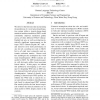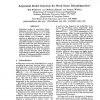80 search results - page 2 / 16 » Simple Features for Chinese Word Sense Disambiguation |
ACL
2003
13 years 6 months ago
2003
A central problem of word sense disambiguation (WSD) is the lack of manually sense-tagged data required for supervised learning. In this paper, we evaluate an approach to automati...
CORR
2004
Springer
13 years 5 months ago
2004
Springer
This paper describes the National Research Council (NRC) Word Sense Disambiguation (WSD) system, as applied to the English Lexical Sample (ELS) task in Senseval-3. The NRC system ...
EMNLP
2007
13 years 7 months ago
2007
We show for the first time that incorporating the predictions of a word sense disambiguation system within a typical phrase-based statistical machine translation (SMT) model cons...
CICLING
2009
Springer
14 years 6 months ago
2009
Springer
We propose a supervised word sense disambiguation (WSD) system that uses features obtained from clustering results of word instances. Our approach is novel in that we employ semi-s...
ANLP
1997
13 years 6 months ago
1997
Statistical models of word-sense disambiguation are often based on a small number of contextual features or on a model that is assumed to characterize the interactions among a set...


